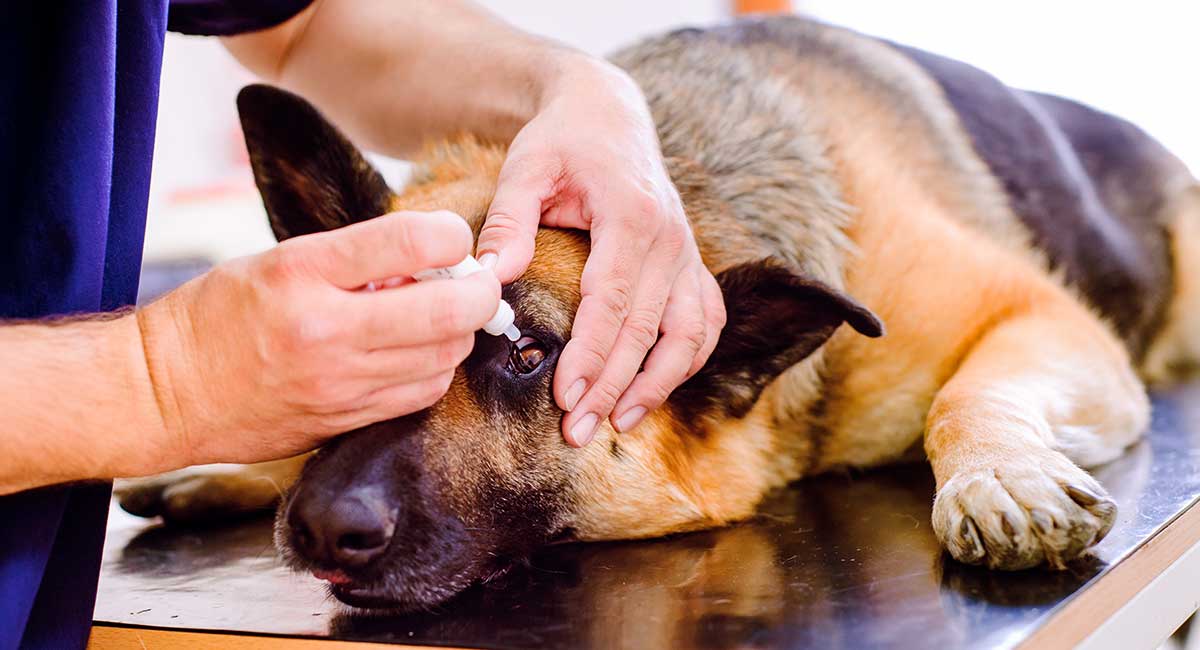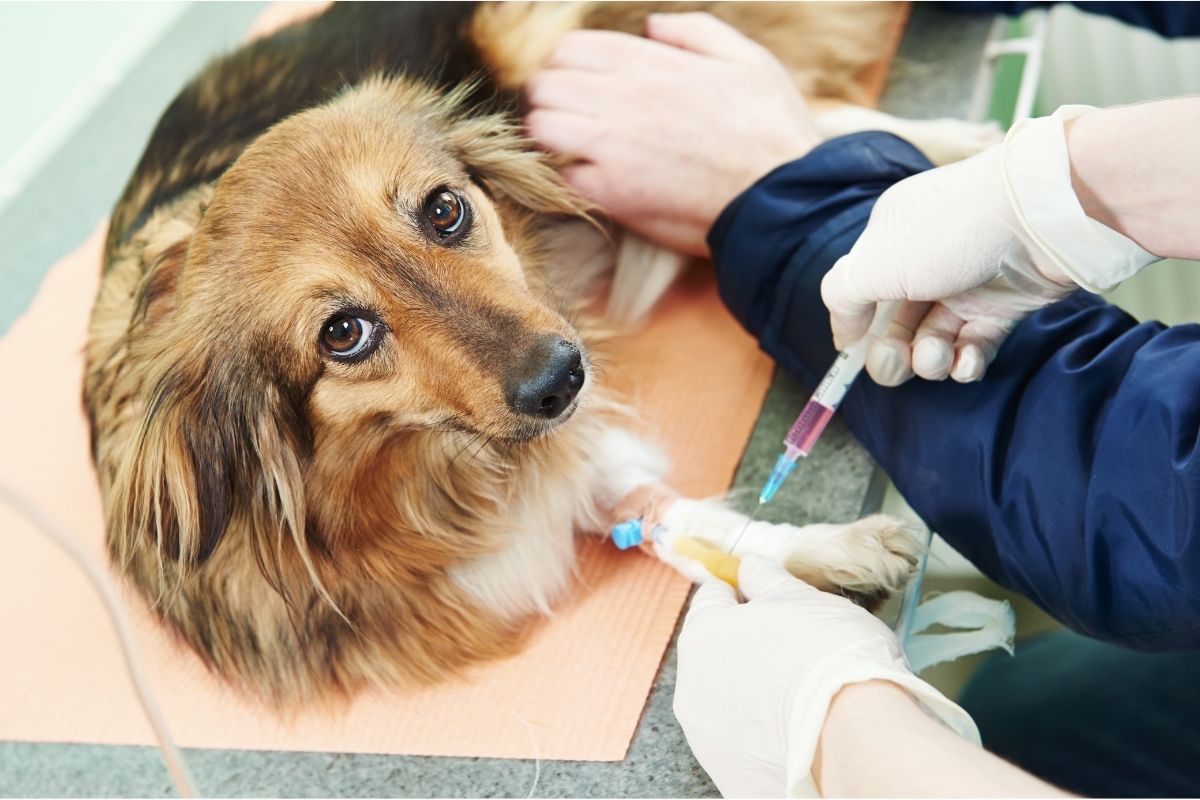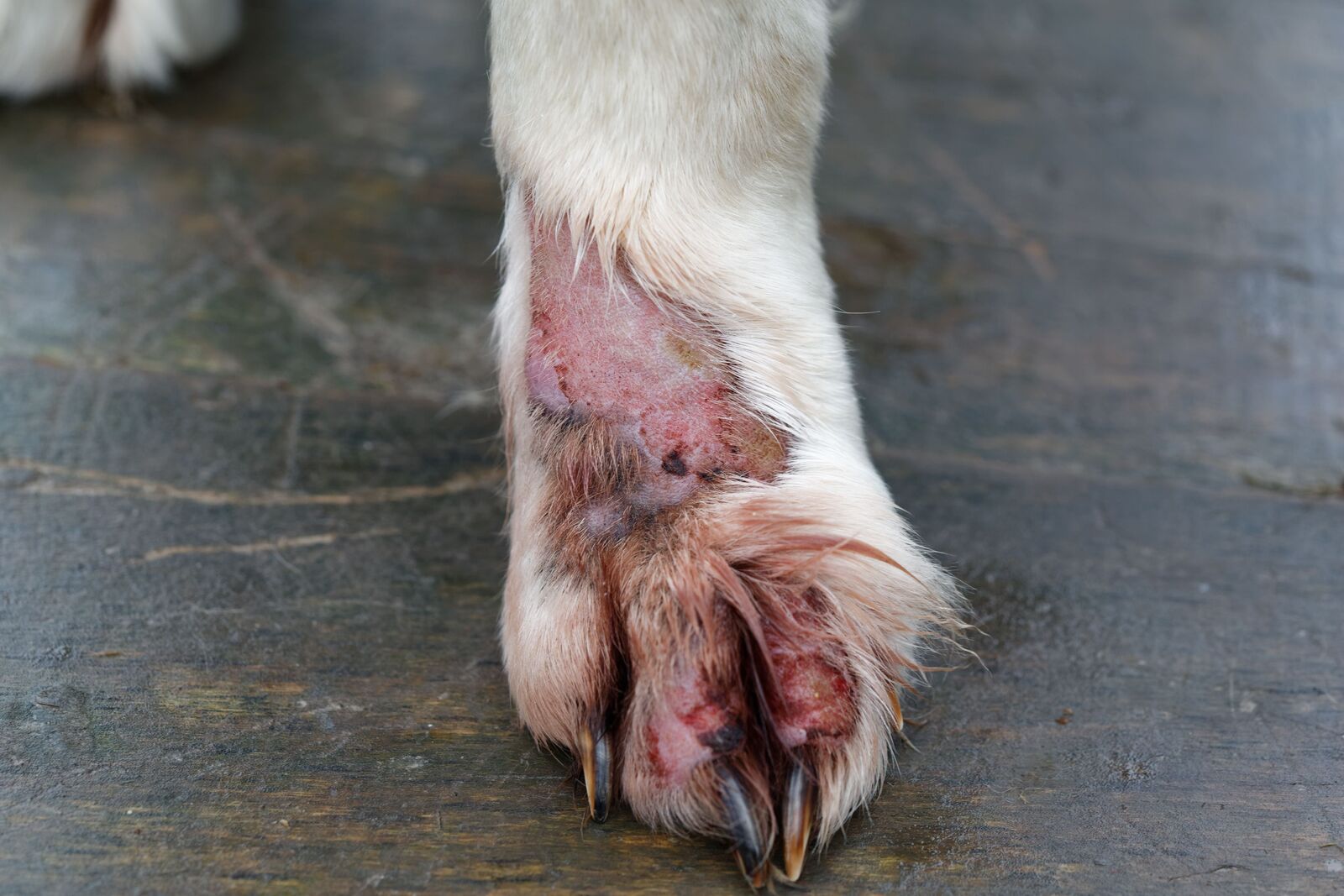Home>Health & Wellness>Common Health Issues>What Parasite Is Passed From Dog To Human


Common Health Issues
What Parasite Is Passed From Dog To Human
Published: February 8, 2024
Learn about common health issues in dogs and the parasite that can be passed from dogs to humans. Protect your family and pets with this important information.
(Many of the links in this article redirect to a specific reviewed product. Your purchase of these products through affiliate links helps to generate commission for Pawsomeoldies.com, at no extra cost. Learn more)
Table of Contents
Introduction
Parasites are organisms that live on or inside another organism, known as the host, and benefit at the host's expense. When it comes to pets, particularly dogs, parasites can pose a significant health risk to both the animals and their human companions. Understanding the potential for parasite transmission from dogs to humans is crucial for safeguarding the well-being of both species.
In this comprehensive guide, we will delve into the world of parasites, exploring the common types found in dogs, how they can be transmitted to humans, the symptoms of parasitic infections in humans, and most importantly, how to prevent and treat these infections.
By shedding light on this topic, we aim to empower dog owners and individuals who come into contact with dogs to make informed decisions and take proactive measures to protect themselves and their furry friends from the potential harm posed by parasites. Let's embark on this enlightening journey to gain a deeper understanding of the parasites that can be passed from dogs to humans and how to mitigate this risk.
Understanding Parasites
Parasites are diverse organisms that thrive by feeding off their hosts, which can be animals, plants, or even humans. In the context of dogs and humans, parasites can encompass a wide range of organisms, including worms, protozoa, fleas, ticks, and mites. These parasites can cause a variety of health issues in both dogs and humans, ranging from mild discomfort to severe illnesses.
Parasites can be broadly categorized into external and internal parasites. External parasites, such as fleas and ticks, reside on the surface of the host's body, while internal parasites, including worms and protozoa, inhabit the internal organs or tissues of the host. Each type of parasite has its own distinct characteristics and life cycle, which influences how they infect and affect their hosts.
Understanding the life cycle of parasites is crucial in comprehending how they spread and cause infections. Many parasites have complex life cycles, involving different stages of development and often requiring intermediate hosts to complete their life cycle. For instance, certain types of worms require ingestion by a host animal to develop into adult worms, while others may be transmitted through the bite of an infected insect.
Moreover, parasites can cause a range of health issues in both dogs and humans. In dogs, common symptoms of parasitic infections may include itching, hair loss, digestive disturbances, anemia, and in severe cases, organ damage. Similarly, humans can experience a variety of symptoms when infected with parasites, such as skin rashes, fever, digestive problems, and in some cases, more serious complications affecting the organs.
It's important to note that parasites not only pose a direct health risk but can also exacerbate pre-existing conditions in both dogs and humans. For example, a weakened immune system in a dog or human may make them more susceptible to severe complications from a parasitic infection.
In summary, parasites are diverse organisms that can cause a range of health issues in both dogs and humans. Understanding the types of parasites, their life cycles, and the potential health implications is crucial in effectively preventing, diagnosing, and treating parasitic infections in both dogs and humans.
Common Parasites in Dogs
Dogs are susceptible to various parasites that can have detrimental effects on their health. Understanding the common parasites that affect dogs is essential for pet owners to recognize the signs of infestation and take appropriate preventive measures. Here are some of the most prevalent parasites found in dogs:
-
Fleas: These tiny, wingless insects are a common nuisance for dogs. Flea infestations can lead to intense itching, skin irritation, and in severe cases, anemia, especially in young or small dogs.
-
Ticks: Ticks are external parasites that attach themselves to the skin of dogs to feed on their blood. They can transmit serious diseases such as Lyme disease and Rocky Mountain spotted fever, posing a significant health risk to both dogs and humans.
-
Roundworms: Roundworms are intestinal parasites that commonly affect dogs, particularly puppies. These worms can cause digestive issues, stunted growth, and in severe cases, intestinal blockages.
-
Hookworms: These blood-feeding parasites can cause anemia and weakness in dogs. Hookworm infestations are particularly concerning in puppies and can lead to life-threatening complications if left untreated.
-
Tapeworms: Tapeworms are segmented parasites that reside in the intestines of dogs. Dogs can become infected by ingesting fleas or small mammals carrying tapeworm larvae. While tapeworm infestations may not always cause noticeable symptoms, they can lead to weight loss and nutritional deficiencies over time.
-
Heartworms: Heartworm disease is a serious and potentially fatal condition transmitted through the bite of infected mosquitoes. These parasites reside in the heart, lungs, and blood vessels of infected dogs, causing severe damage to these vital organs.
-
Ear Mites: These tiny parasites infest the ears of dogs, leading to intense itching, ear inflammation, and discomfort. If left untreated, ear mite infestations can result in secondary ear infections and hearing loss.
-
Demodex Mites: Demodex mites are microscopic parasites that reside in the hair follicles and oil glands of dogs. While these mites are a natural part of the skin flora, overpopulation can lead to a condition known as demodectic mange, characterized by hair loss, skin lesions, and secondary bacterial infections.
By familiarizing themselves with these common parasites, dog owners can proactively protect their pets from infestations and minimize the risk of transmission to humans. Regular veterinary check-ups, preventive medications, and maintaining a clean living environment are essential in preventing and managing parasite infestations in dogs.
How Parasites are Transmitted to Humans
Parasites that affect dogs have the potential to be transmitted to humans, posing a health risk known as zoonotic disease transmission. The transfer of parasites from dogs to humans can occur through various pathways, and understanding these modes of transmission is crucial for preventing human infections. Here are the primary ways in which parasites can be transmitted from dogs to humans:
-
Direct Contact: Certain parasites, such as sarcoptic mange mites and ringworm fungi, can be directly transmitted from infected dogs to humans through skin-to-skin contact. Sarcoptic mange, also known as scabies, is a highly contagious skin infestation caused by the Sarcoptes scabiei mite. When dogs are infested with these mites, close contact with the infected animal can lead to the transfer of mites to humans, resulting in intense itching and skin irritation.
-
Ingestion of Infective Stages: Some parasites, particularly intestinal worms like roundworms and hookworms, release eggs or larvae into the environment through the feces of infected dogs. If humans inadvertently ingest these infective stages, either through direct contact with contaminated soil or improperly washed hands, they can become infected. This mode of transmission is particularly concerning in young children who may come into contact with contaminated soil while playing outdoors.
-
Vector-Borne Transmission: Certain parasites, such as ticks and fleas, can act as vectors for transmitting diseases from dogs to humans. When ticks or fleas infest dogs and subsequently bite humans, they can transmit disease-causing pathogens, including bacteria and protozoa, leading to infections such as Lyme disease and bartonellosis. It's important to note that preventing tick and flea infestations in dogs is crucial for reducing the risk of vector-borne diseases in humans.
-
Environmental Contamination: Parasite eggs, larvae, or cysts shed by infected dogs can contaminate the surrounding environment, including soil, water, and surfaces within the home. Humans can inadvertently come into contact with these infectious stages, leading to potential infections. Proper hygiene practices, such as regular handwashing and thorough cleaning of living spaces, are essential for minimizing the risk of environmental transmission.
-
Inhalation of Infective Stages: In the case of certain parasites, such as lungworms, the infective stages can be present in the environment and may be inadvertently inhaled by humans. While the risk of human infection with lungworms is relatively low, it underscores the importance of maintaining a clean living environment and minimizing exposure to potentially contaminated areas.
Understanding how parasites are transmitted from dogs to humans empowers individuals to take proactive measures to reduce the risk of zoonotic infections. By implementing proper hygiene practices, regular veterinary care for dogs, and preventive measures to control parasites in pets and their living environments, the likelihood of human infections can be significantly mitigated.
Symptoms of Parasitic Infections in Humans
Parasitic infections in humans, resulting from the transmission of parasites from dogs, can manifest in a variety of symptoms, ranging from mild discomfort to severe health complications. It's crucial for individuals who come into contact with dogs, particularly pet owners and those working in animal-related professions, to be aware of the potential signs of parasitic infections. By recognizing these symptoms early, prompt medical intervention can be sought to address the underlying infections. Here are the common symptoms of parasitic infections in humans resulting from exposure to infected dogs:
-
Skin Irritation and Rashes: Certain parasitic infestations, such as those caused by sarcoptic mange mites and fleas, can lead to intense itching, skin irritation, and the development of rashes. Individuals may experience redness, raised bumps, and a persistent itching sensation, particularly in areas of skin-to-skin contact with infected dogs or contaminated environments.
-
Digestive Disturbances: Ingestion of parasite eggs or larvae, often through contaminated soil or improperly washed hands after handling infected dogs, can lead to digestive issues in humans. Symptoms may include abdominal pain, diarrhea, nausea, and in some cases, vomiting. Intestinal parasites such as roundworms and hookworms can cause significant discomfort and disrupt normal digestive function.
-
Flu-Like Symptoms: Some parasitic infections can present with flu-like symptoms, including fever, fatigue, and muscle aches. These symptoms may be indicative of systemic infections caused by certain parasites transmitted from dogs, such as tick-borne pathogens and protozoa. Individuals may experience a general feeling of malaise and unexplained fatigue.
-
Respiratory Issues: In the case of certain parasites, such as lungworms, individuals may experience respiratory symptoms, including coughing, shortness of breath, and chest discomfort. Inhalation of infective stages of lungworms, often present in contaminated environments, can lead to respiratory infections and inflammation.
-
Localized Swelling and Inflammation: Parasitic infections transmitted through vectors like ticks and fleas can result in localized swelling and inflammation at the site of the parasite bite. Individuals may notice redness, swelling, and tenderness, particularly if they have been bitten by infected vectors.
-
Neurological Symptoms: In rare cases, certain parasitic infections can affect the central nervous system, leading to neurological symptoms such as headaches, confusion, and sensory disturbances. These symptoms may indicate a more severe parasitic infection that requires immediate medical attention.
It's important to note that the symptoms of parasitic infections in humans can vary depending on the type of parasite involved, the individual's immune response, and the extent of exposure. Additionally, some parasitic infections may present with nonspecific symptoms that overlap with other common health conditions, making accurate diagnosis challenging without proper medical evaluation.
In summary, being vigilant about the potential symptoms of parasitic infections resulting from exposure to infected dogs is essential for early detection and appropriate medical management. Individuals experiencing any of the aforementioned symptoms, especially after close contact with dogs or potential exposure to contaminated environments, should seek medical advice to determine the underlying cause and receive timely treatment.
Read more: What Parasite Do You Get From Dog Kisses?
Preventing Parasite Transmission from Dogs to Humans
Preventing parasite transmission from dogs to humans is paramount in safeguarding the health and well-being of both pets and their human companions. By implementing proactive measures and adhering to best practices, individuals can significantly reduce the risk of zoonotic infections caused by parasites. Here are essential strategies for preventing parasite transmission from dogs to humans:
-
Regular Veterinary Care: Scheduled veterinary visits are crucial for maintaining the health of dogs and preventing parasite infestations. Veterinarians can conduct comprehensive examinations, administer preventive medications, and recommend appropriate parasite control measures tailored to the specific needs of each dog. By adhering to a veterinarian-recommended parasite prevention regimen, pet owners can minimize the risk of parasitic infections in their dogs, consequently reducing the likelihood of transmission to humans.
-
Parasite Control Products: Utilizing veterinarian-prescribed parasite control products, such as flea and tick preventives, dewormers, and heartworm preventives, is instrumental in managing and preventing parasite infestations in dogs. These products are designed to target specific parasites and provide ongoing protection, effectively reducing the risk of transmission to humans. It is essential for pet owners to follow the recommended dosing schedules and application methods for these products to ensure optimal efficacy.
-
Environmental Hygiene: Maintaining a clean living environment for dogs is essential in minimizing the risk of environmental transmission of parasites to humans. Regularly cleaning and disinfecting living spaces, washing pet bedding, and promptly removing feces from outdoor areas can help reduce the environmental burden of parasites. Additionally, practicing good hygiene, such as washing hands after handling dogs or engaging in outdoor activities, can further mitigate the risk of human exposure to infectious parasite stages.
-
Vector Control: Preventing infestations of external parasites, such as fleas and ticks, is crucial for reducing the risk of vector-borne diseases in both dogs and humans. Employing effective flea and tick control measures, including topical treatments, collars, and environmental control products, can help mitigate the risk of vector-borne parasite transmission. Regular inspection of dogs for signs of fleas and ticks, particularly after outdoor activities, is essential for early detection and prompt intervention.
-
Education and Awareness: Educating individuals, especially pet owners and those working in animal-related professions, about the risks of parasite transmission from dogs to humans is vital. Providing information on the common parasites found in dogs, their modes of transmission, and preventive measures empowers individuals to make informed decisions and take proactive steps to protect themselves and their families. Additionally, raising awareness about the importance of regular veterinary care and parasite prevention can contribute to a healthier and safer environment for both dogs and humans.
By diligently implementing these preventive strategies, individuals can create a safer and healthier environment for dogs and humans alike, effectively reducing the risk of parasite transmission and zoonotic infections. Proactive measures, combined with regular veterinary care and responsible pet ownership, play a pivotal role in mitigating the impact of parasites and promoting the well-being of both canine companions and their human counterparts.
Treatment for Parasitic Infections in Humans
When parasitic infections are diagnosed in humans, prompt and appropriate treatment is essential to address the underlying infections and alleviate associated symptoms. The specific approach to treating parasitic infections in humans depends on the type of parasite involved, the severity of the infection, and the individual's overall health. Here are the key aspects of treatment for parasitic infections in humans:
Medical Evaluation and Diagnosis
Upon experiencing symptoms suggestive of a parasitic infection, individuals should seek medical evaluation to determine the underlying cause. Healthcare providers may conduct a thorough physical examination, review the individual's medical history, and order diagnostic tests to identify the presence of parasites or their associated markers in the body. These tests may include stool examinations, blood tests, imaging studies, and in some cases, skin biopsies for certain parasitic skin infections.
Antiparasitic Medications
The cornerstone of treatment for parasitic infections in humans involves the use of antiparasitic medications, also known as anthelmintics or antiprotozoal drugs, depending on the type of parasite being targeted. These medications are designed to eliminate the parasites from the body and may be administered orally, topically, or intravenously, depending on the specific medication and the nature of the infection. The choice of antiparasitic medication is guided by the type of parasite, the individual's age, weight, and overall health, as well as any underlying medical conditions.
Supportive Care
In addition to antiparasitic medications, individuals with parasitic infections may require supportive care to manage associated symptoms and complications. This may include medications to alleviate gastrointestinal distress, skin irritation, or systemic symptoms such as fever and pain. Adequate hydration, rest, and a nutritious diet are also important components of supportive care to aid in the individual's recovery from the infection.
Follow-Up Monitoring
Following the initiation of treatment, healthcare providers may recommend follow-up appointments to monitor the individual's response to the antiparasitic medications and assess for any potential side effects. In some cases, repeat diagnostic tests may be conducted to confirm the clearance of parasites from the body. Close monitoring is particularly important in cases of severe or systemic parasitic infections to ensure the effectiveness of treatment and the individual's overall recovery.
Prevention of Recurrence
After successful treatment of a parasitic infection, individuals should be educated on preventive measures to minimize the risk of recurrence. This may include practicing good hygiene, avoiding exposure to contaminated environments, and implementing preventive measures for pets to reduce the risk of zoonotic parasite transmission. Additionally, individuals should adhere to any post-treatment recommendations provided by healthcare providers to prevent reinfection and promote long-term wellness.
In summary, the treatment of parasitic infections in humans involves a comprehensive approach that encompasses accurate diagnosis, targeted antiparasitic medications, supportive care, and follow-up monitoring. By addressing parasitic infections effectively and implementing preventive measures, individuals can achieve recovery and reduce the risk of future infections, thereby promoting overall health and well-being.
Conclusion
In conclusion, the potential for parasite transmission from dogs to humans underscores the importance of proactive measures to safeguard the health and well-being of both pets and their human companions. Understanding the common parasites found in dogs, their modes of transmission to humans, and the associated symptoms is pivotal in mitigating the risk of zoonotic infections. By fostering awareness and implementing preventive strategies, individuals can create a safer and healthier environment for dogs and humans alike.
The comprehensive guide has shed light on the diverse world of parasites, encompassing external and internal organisms that can cause a range of health issues in both dogs and humans. From fleas and ticks to intestinal worms and mites, the prevalence of these parasites underscores the need for vigilance and preventive action. By recognizing the signs of parasitic infestations in dogs and understanding the potential modes of transmission to humans, pet owners and individuals in close contact with dogs can take proactive steps to minimize the risk of zoonotic infections.
Furthermore, the guide has emphasized the significance of regular veterinary care, parasite control products, environmental hygiene, vector control, and education in preventing parasite transmission. These proactive measures, when diligently implemented, can significantly reduce the environmental burden of parasites and mitigate the risk of zoonotic infections. By adhering to best practices and maintaining a clean and safe living environment for dogs, individuals can create a harmonious and healthy coexistence with their canine companions.
In the event of parasitic infections in humans, timely medical evaluation, accurate diagnosis, and appropriate treatment are essential for addressing the underlying infections and promoting recovery. Antiparasitic medications, supportive care, and follow-up monitoring play crucial roles in managing parasitic infections and preventing recurrence. By combining effective treatment with preventive measures, individuals can minimize the impact of parasitic infections and promote long-term wellness.
Ultimately, the knowledge and proactive measures outlined in this guide empower individuals to make informed decisions and take responsible actions to protect themselves, their pets, and their families from the potential harm posed by parasites. By fostering a culture of awareness, education, and preventive care, we can create a safer and healthier environment for both dogs and humans, fostering a bond built on well-being and mutual care.













